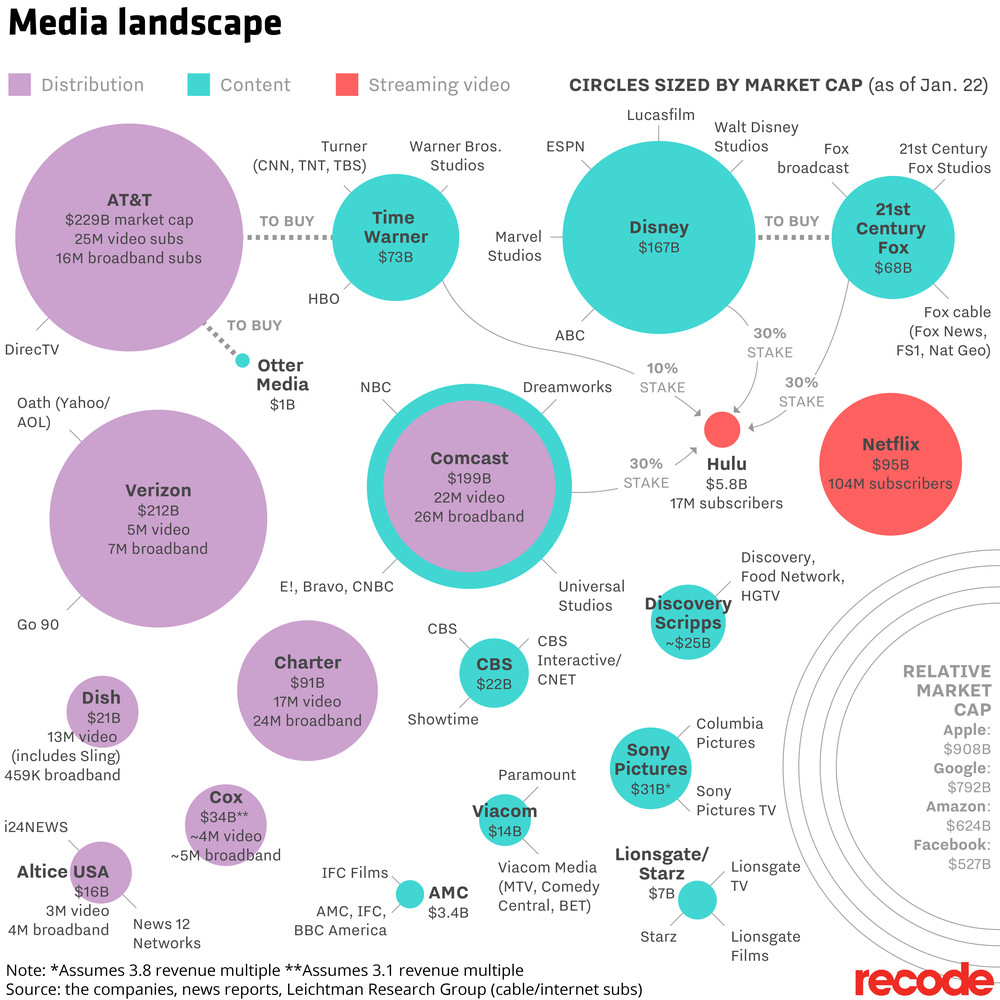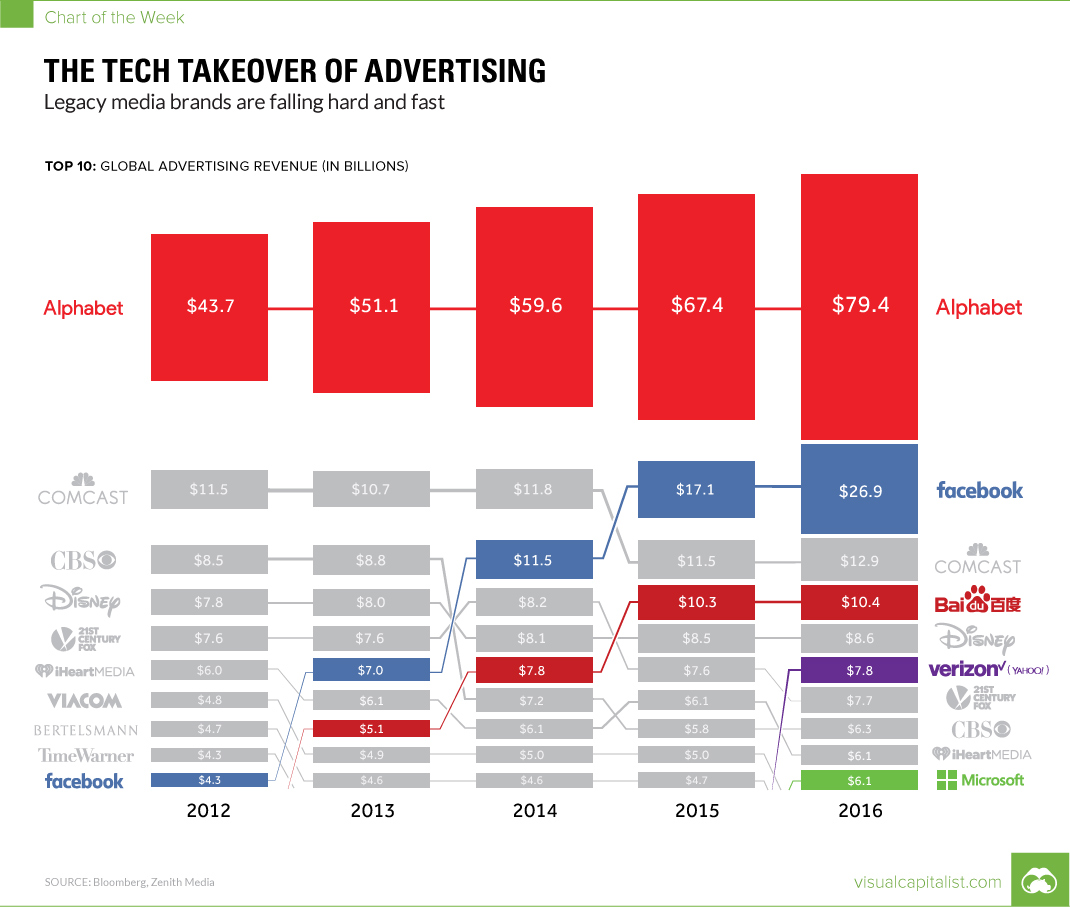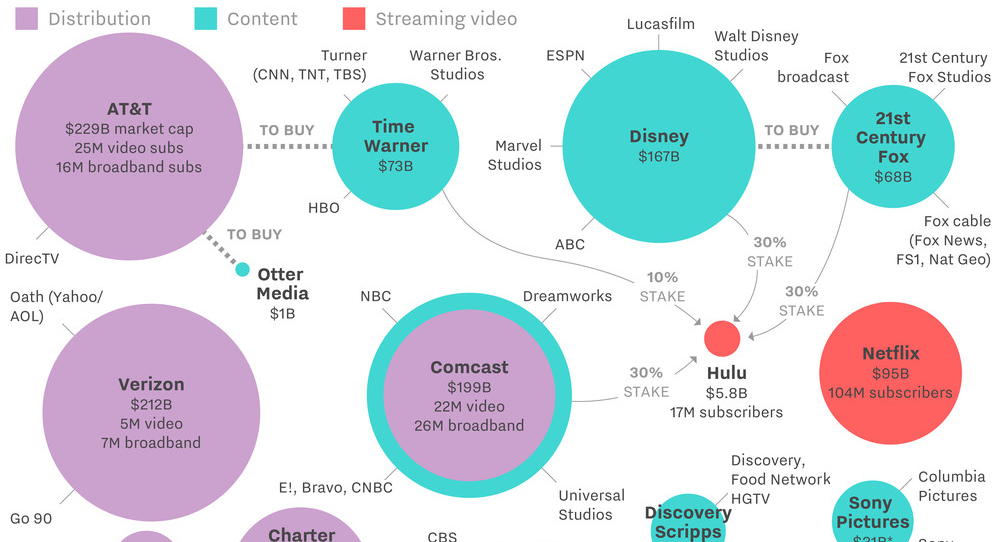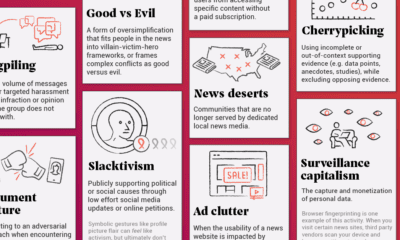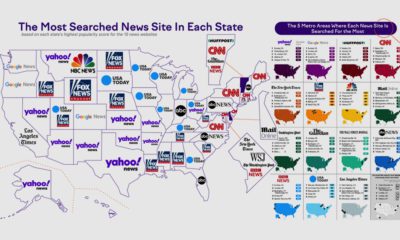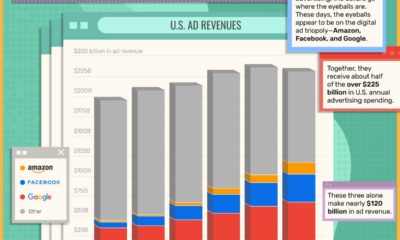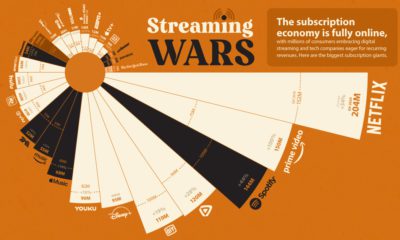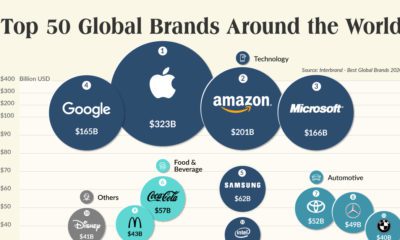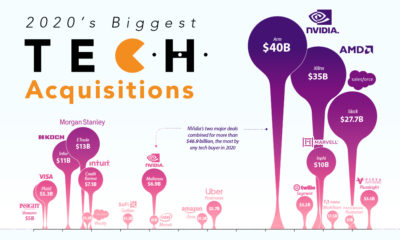With immense pressure on revenues, market share, and distribution stemming from platforms and the migration to digital, the traditional big media players are scrambling to find new models and tactics that work. In addition to forcing companies to evaluate new ways to monetize and distribute content, this industry turmoil has also served up the perfect environment for massive mergers and acquisitions. Big conglomerates aren’t going to go down without a fight, and as a result they are willing to “bet the farm” on M&A to try and compete.
The Big Media Landscape
Today’s visualization comes to us from Recode via media reporters Peter Kafka and Rani Molla, and it does an excellent job in summing up the changing landscape of Big Media. Notably, it helps visualize the significance of the recent $52.4 billion merger between Disney and 21st Century Fox, as well as the $85 billion merger between AT&T and Time Warner. The latter is set to go to antitrust trials in March.
It’s worth noting that the above graphic only shows the big players in the media landscape – and new media companies like Buzzfeed ($1.7 billion valuation) and Vox Media ($1.0 billion) are “too small” to include. As such, it focuses primarily on the conglomerates that own many different media assets, with a heavy slant towards video content and distribution.
Platform Takeover
The impetus behind much of the turmoil in the media space comes from the unrivaled success of platforms. Netflix has quickly emerged as a $100 billion+ company, and it already outsizes content stalwarts like Time Warner and 21st Century Fox, which each have histories going back many decades. In response? In the visualization, you can see the investments made by Disney, Comcast, 21st Century Fox, and Time Warner into video streamer Hulu in one attempt to hedge bets. But unfortunately, it’s not only Netflix that is a threat – on the advertising side, the Google/Facebook duopoly is wreaking havoc on virtually every online media company in existence. The below graphic, which helps to contextualize the trend in global ad revenue, is from a previous chart we published last year.
To combat a shrinking share of the pie, even long-running brands like the New York Times are migrating their monetization strategy towards paid subscriptions. In other words, even the Times acknowledges that it can’t compete with the scale and targeting ability of the platforms. That’s why, unless the dust settles in the near-term, there will be even more consolidation and attempts towards innovation in the media sector. This is especially true for the big conglomerates, who need to show shareholders that they are trying to do something to stop the bleeding.
on But fast forward to the end of last week, and SVB was shuttered by regulators after a panic-induced bank run. So, how exactly did this happen? We dig in below.
Road to a Bank Run
SVB and its customers generally thrived during the low interest rate era, but as rates rose, SVB found itself more exposed to risk than a typical bank. Even so, at the end of 2022, the bank’s balance sheet showed no cause for alarm.
As well, the bank was viewed positively in a number of places. Most Wall Street analyst ratings were overwhelmingly positive on the bank’s stock, and Forbes had just added the bank to its Financial All-Stars list. Outward signs of trouble emerged on Wednesday, March 8th, when SVB surprised investors with news that the bank needed to raise more than $2 billion to shore up its balance sheet. The reaction from prominent venture capitalists was not positive, with Coatue Management, Union Square Ventures, and Peter Thiel’s Founders Fund moving to limit exposure to the 40-year-old bank. The influence of these firms is believed to have added fuel to the fire, and a bank run ensued. Also influencing decision making was the fact that SVB had the highest percentage of uninsured domestic deposits of all big banks. These totaled nearly $152 billion, or about 97% of all deposits. By the end of the day, customers had tried to withdraw $42 billion in deposits.
What Triggered the SVB Collapse?
While the collapse of SVB took place over the course of 44 hours, its roots trace back to the early pandemic years. In 2021, U.S. venture capital-backed companies raised a record $330 billion—double the amount seen in 2020. At the time, interest rates were at rock-bottom levels to help buoy the economy. Matt Levine sums up the situation well: “When interest rates are low everywhere, a dollar in 20 years is about as good as a dollar today, so a startup whose business model is “we will lose money for a decade building artificial intelligence, and then rake in lots of money in the far future” sounds pretty good. When interest rates are higher, a dollar today is better than a dollar tomorrow, so investors want cash flows. When interest rates were low for a long time, and suddenly become high, all the money that was rushing to your customers is suddenly cut off.” Source: Pitchbook Why is this important? During this time, SVB received billions of dollars from these venture-backed clients. In one year alone, their deposits increased 100%. They took these funds and invested them in longer-term bonds. As a result, this created a dangerous trap as the company expected rates would remain low. During this time, SVB invested in bonds at the top of the market. As interest rates rose higher and bond prices declined, SVB started taking major losses on their long-term bond holdings.
Losses Fueling a Liquidity Crunch
When SVB reported its fourth quarter results in early 2023, Moody’s Investor Service, a credit rating agency took notice. In early March, it said that SVB was at high risk for a downgrade due to its significant unrealized losses. In response, SVB looked to sell $2 billion of its investments at a loss to help boost liquidity for its struggling balance sheet. Soon, more hedge funds and venture investors realized SVB could be on thin ice. Depositors withdrew funds in droves, spurring a liquidity squeeze and prompting California regulators and the FDIC to step in and shut down the bank.
What Happens Now?
While much of SVB’s activity was focused on the tech sector, the bank’s shocking collapse has rattled a financial sector that is already on edge.
The four biggest U.S. banks lost a combined $52 billion the day before the SVB collapse. On Friday, other banking stocks saw double-digit drops, including Signature Bank (-23%), First Republic (-15%), and Silvergate Capital (-11%).
Source: Morningstar Direct. *Represents March 9 data, trading halted on March 10.
When the dust settles, it’s hard to predict the ripple effects that will emerge from this dramatic event. For investors, the Secretary of the Treasury Janet Yellen announced confidence in the banking system remaining resilient, noting that regulators have the proper tools in response to the issue.
But others have seen trouble brewing as far back as 2020 (or earlier) when commercial banking assets were skyrocketing and banks were buying bonds when rates were low.
